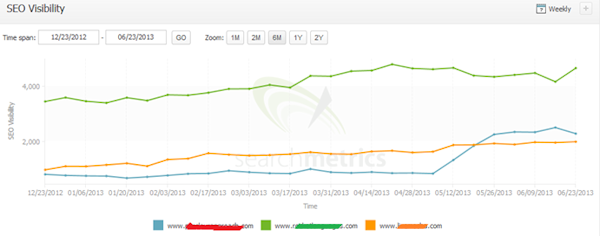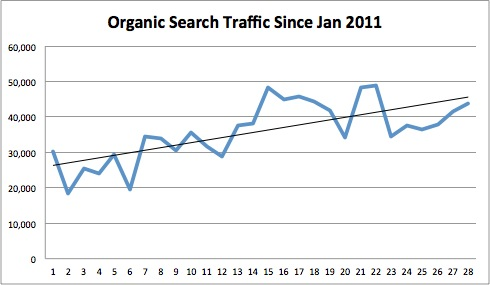 Economists regularly use leading indicators — the measurable economic factors that change before the economy as a whole changes — in order to analyze and predict future performance. Lagging indicators, on the other hand, are factors that change after the economy as a whole does.
Economists regularly use leading indicators — the measurable economic factors that change before the economy as a whole changes — in order to analyze and predict future performance. Lagging indicators, on the other hand, are factors that change after the economy as a whole does.
Since SEO is typically a long-term strategy, clients tend to gauge success based on what would be more of a lagging indicator (i.e., profits). Proving the worth of a campaign on this sole lagging indicator can be inadequate, as profits will only come in after the SEO channel as a whole has changed sufficiently.
Clients can get antsy as they wait for their goals to be reached, and though a link building campaign may be going spectacularly well from an SEO professional’s vantage point, the time it takes for links to mature may be something many non-SEO folk have difficulty fully grasping.
By borrowing the economist’s mindset and identifying a core set of SEO leading indicators, we can better showcase how things are progressing to clients or senior management. This allows small wins to be celebrated or problems to be identified and understood by the client throughout the life of the campaign.
More valuably, these quick reports will build the client’s understanding of the different KPIs we SEO professionals monitor, and will be great for assuaging impatient clients and sparking a very productive dialogue each month.
In addition to being uber-useful, the five SEO leading indicators outlined below are quick and easy to pull together and review. While SEO professionals might be very familiar with some of these, and may review them in depth, the trick here is to boil them down into the bare essentials (i.e., the top-level view that clients can quickly read and easily understand).
1. SEO Visibility (with Competitive Intelligence)
Want to be able to monitor progress over time, not just for your site, but for your competitors as well? What if you could see this data in a single graph with just the push of a button?
Co-founded by the noted SEO analyst Marcus Tober, SearchMetrics is a phenomenal SEO analytics tool that tracks a vast amount of actionable data and presents it in concise and easy-to-read formats.
Use their SEO Visibility report to track the current trend and historical development of a domain’s visibility in search engines. Essentially, the index reflects how often a website shows up in the search results. You can even add in up to four competitors to track against as well.

As per SearchMetrics, SEO visibility is composed of search volume and the position of ranking keywords, wherein each position is individually measured by a specially calculated factor based on their formulae.
Why use this as a leading indicator?
Looking at this historical, top-level view of the site’s visibility in the search engines allows for both problems as well as improvements to be quickly identified.
Additionally, comparing the SEO visibility of thematically similar websites or competitors will provide the most value as industry-wide developments will be factored in and market trends easily identified.
It’s also a great way to benchmark the client against their competitors and show how the campaign has been growing.
2. Links Acquired
Showing how content-based outreach or link building efforts have grown the link profile of a company validates the effort put in and can succinctly convey the success of these efforts.
Here we’ve quickly pulled the report of backlinks discovered from Majestic SEO, which can showcase the progress of link building in a simple graph.

Why use this as a leading indicator?
If link building is done well, there is often a correlation between the growth of incoming links and an increase in the search visibility metric that can make a case for causation to the client, that essentially the improvement in the link building campaign is showing improvements in search visibility.
This can often help make the case for increased budgets for content or outreach efforts to the clients, since they can tie it back to actual numbers and see the trend.
3. Domain Authority
Domain Authority represents Moz’s best prediction about how a website will perform in the search engine rankings. It is a good indicator of trust of the site, quality of the link profile, user behavior and likelihood of a domain ranking higher up in the SERPs.
Note that since domain authority can sometimes fluctuate, it’s not a precise historical measure to use, but snapshots of the score over time can be a good indicator, especially if the score changes by several points.

Why use this as a leading indicator?
Essentially, the higher the domain authority, the better the chances for overtaking competitors who rank higher and the better trust signal in the eyes of the search engines.
Use this to explain to clients the quality of the SEO work being done, since a well-executed campaign that builds trusted, high-quality links while emphasizing a better user experience on site, will typically yield higher domain authority scores.
A higher domain authority site will be more competitive in the rankings and have a higher chance of moving up in the rankings.
4. Search Traffic
A simple snapshot of organic search traffic trends pulled from Google Analytics provides a useful graph to see how SEO efforts have grown traffic over time.

Why use this as a leading indicator?
Comparing monthly visits at the start of the campaign to the present time is a simple and easy-to-digest metric to showcase the progress and success of the campaign.
As keywords move up in the SERPs to reach the tipping point for click-through rate and outreach efforts create more searches for the brand, the organic search traffic is bound to improve, and will show the growth created simply as a result of SEO efforts alone.
5. Core Rankings
Often we share with clients large lists of keyword rankings. Especially for clients with very large volumes of keywords to monitor, these reports can get cumbersome and thus ignored far too often. On a twice monthly basis, take the top 10 highest value keywords for the client and run manual rank checks to track progress over time.

Why use this as a leading indicator?
A shortlist of the highest value keywords will be of the most interest to the clients and will show how close to the tipping point they are; thus clients can see how much closer they are to their ultimate goal of large volume increases in profit. Use an easy-to-read key, such as a highlight for keywords on page 1, green to show improvements and red to show declines in rankings.
Your Top SEO Leading Indicators?
Are there other SEO leading indicators that you use? Share your thoughts in the comments below.
 Economists regularly use leading indicators — the measurable economic factors that change before the economy as a whole changes — in order to analyze and predict future performance. Lagging indicators, on the other hand, are factors that change after the economy as a whole does.
Economists regularly use leading indicators — the measurable economic factors that change before the economy as a whole changes — in order to analyze and predict future performance. Lagging indicators, on the other hand, are factors that change after the economy as a whole does.



